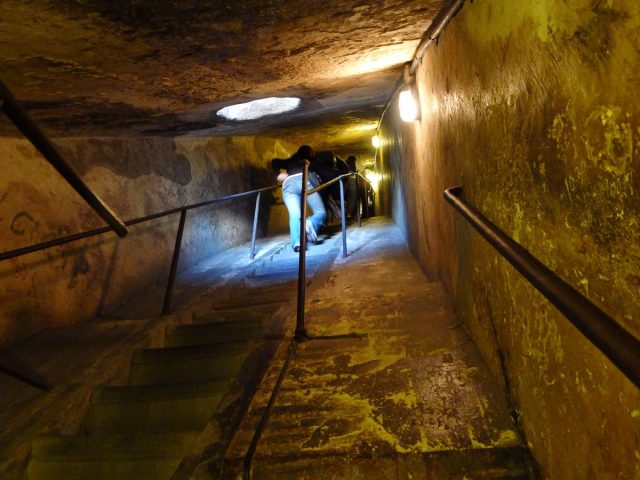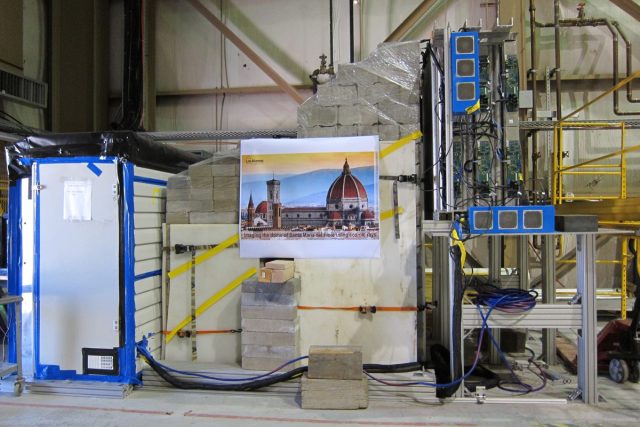The soaring dome atop the Cathedral of St. Mary of the Flower justly dominates the Florence skyline and has stood for centuries, ever since Filippo Brunelleschi designed it in the early 15th century. But scholars aren't quite sure how this goldsmith with no formal architectural training managed to construct it. Brunelleschi built a wooden and brick model of his plan, but deliberately left out crucial details and left no comprehensive blueprints so his rivals could not steal his secrets.
Elena Guardincerri, a physicist at Los Alamos National Laboratory who grew up in a nearby town in Italy, thinks she can help resolve part of the mystery with the aid of a subatomic particle called a muon.
Inverted tension
Brunelleschi found inspiration for his design in the inverted catenary shape of the Pantheon, which is an ideal shape for domes because the innate physical forces can support the structure with no need for buttressing. Robert Hooke phrased it best in the 17th century: "As hangs the flexible chain, so but inverted stands the rigid arch." A chain suspended between two points will naturally come to rest in a state of pure tension; inverting that catenary shape into an arch reverses it into a shape of pure compression. Standard building materials like masonry and concrete would break fairly easily under tension, but they can withstand large compressive forces.
The Pantheon's circular dome has a single concrete shell. Brunelleschi's design called for an octagonal dome spanning 150 feet and soaring nearly 300 feet in height with no flying buttresses for support. He used two shells: a very thick inner shell and a much thinner outer shell. Historians believe he used three pairs of large stone chains (which are still part of the structure) to act a bit like barrel hoops, applying sufficient pressure to hold the bricks in place while the mortar set.

The final dome is a spectacular achievement. Almost immediately, however, cracks began to appear in the structure, albeit very slow-moving cracks. "Nobody is expecting it to fall down any time soon," said Guardincerri. But a botched restoration effort in the 1980s exacerbated the problem, adding a greater sense of urgency to the quest to preserve the dome, which is one of Florence's chief tourist attractions. However, the lack of detailed information about the internal structure remains a stumbling block.
Preservationists have employed many different methods over the years attempting to fill in their gaps in knowledge. In 1987, 300 different devices were hooked up to the dome, prompting The New York Times to declare it "the world's most carefully monitored structure." But the inner shell is so thick, most conventional methods can't penetrate it. Specifically, it would be nice to know whether the stone chains used to stabilize the dome were reinforced with iron bars, clamps, or more chains to fortify its structural integrity. That's where muon imaging should be able to help.
The magical muon
There is a long history of using muons to image archaeological structures, a process made easier by the fact that cosmic rays provide a steady supply of these particles. An engineer named E.P. George used them to make measurements of an Australian tunnel in the 1950s. But Nobel-prize-winning physicist Luis Alvarez really put muon imaging on the map when he teamed up with Egyptian archaeologists to use the technique to search for hidden chambers in the Pyramid of Khafre at Giza. Although it worked in principle, they didn't find any hidden chambers. Just last year, however, scientists used muon imaging to detect a mysterious void in the Great Pyramid of Giza, which could be evidence of a hidden chamber.
There are many variations of muon imaging, but they all typically involve gas-filled chambers. As muons zip through the gas, they collide with the gas particles and emit a telltale flash of light, which is recorded by the detector so scientists can calculate the particle's energy and trajectory. It's similar to X-ray imaging or ground-penetrating radar, except with naturally occurring high-energy muons rather than X-rays or radio waves. That higher energy makes it possible to image very thick, dense substances, like the stones used to build pyramids or Il Duomo's seven-foot-thick inner shell. The denser the object being imaged, the more muons are blocked, casting a telltale shadow. Hidden chambers in a pyramid would show up in the final image because they blocked fewer particles. And if Brunelleschi used iron bars to fortify his dome, they would show up as darker patches.
The Los Alamos muon tracking technique was first developed in the early 2000s when Guardincerri was still a graduate student. She originally built her muon detectors to prevent the pesky particles from interfering with her attempts to study ghostly neutrinos. When a host of experts on the Florence Cathedral came to a workshop at the lab in 2013, she realized the same technique could be used to learn more about the materials used to build the dome—except she would need to build two smaller, portable detectors.
It takes two
A single muon detector works well for scanning large objects like pyramids or mountains, but there is so much scattering of the muons that you get lower resolution and blurry images. Sandwiching the object of interest between two muon detectors gives you higher resolution, but it limits the field of view to whatever part of the object is between them. That's an acceptable tradeoff for imaging Il Duomo.
Over the summer in 2015, Guardincerri and her students built a mock-up of the dome's thick inner shell out of radiation-shielding concrete bricks, which have similar properties to the clay bricks used to build the original, and embedded iron bars of varying thickness within it. They placed the muon trackers on either side of the six-foot-thick mock-up wall and took data for 35 days. After just 17 days, all three iron bars were clearly visible in the resulting image. When she reported her findings to the cathedral's guild members, she quickly gained approval to develop a set of muon-tracking modules to install on site.

The two detectors are completed, and Guardincerri is now waiting on collaborators at the University of Pennsylvania to finish testing the custom-made electronics for analyzing the data, based on technology used in the ATLAS experiment at CERN's Large Hadron Collider in Switzerland. Once that's done, both detectors will be shipped to other collaborators at the University of Florence, who will retest them to ensure nothing was damaged during transit.
Then the detectors will be mounted in the dome itself: one will press against the inside wall, and the second will rest between the two shells, also against the inner wall. The Florence scientists will collect data for a month in that position and then move the detectors two meters higher for another month of data collection, and so on, until the entire dome has been imaged. And then we may know once and for all whether there are any iron reinforcements in the dome. That would be welcome news to preservationists as they ponder how to address the cracking problem.
DOI: AIP Advances, 2016. 10.1063/1.4940897 (About DOIs).
[contf] [contfnew] 
Ars Technica
[contfnewc] [contfnewc]







